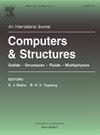Grammar-based generation of strut-and-tie models for designing reinforced concrete structures
IF 4.4
2区 工程技术
Q1 COMPUTER SCIENCE, INTERDISCIPLINARY APPLICATIONS
引用次数: 0
Abstract
Reinforced concrete structures featuring discontinuity regions are complex to design and often susceptible to errors linked to numerical analysis methods. For such structural design problems, strut-and-tie models offer a simple, intuitive and safe design method based on the lower bound theorem of plasticity. Although intuitive, the derivation of strut-and-tie models requires nonnegligible effort and a certain degree of expertise to navigate the highdimensional design space. The automated generation of strut-and-tie models is nontrivial with existing optimisation-based methods, which struggle with accounting for fabrication aspects or incorporating user adaptations.
This paper presents a novel grammar-based approach for generating practical strut-and-tie models by representing them as graphs and constructing a graph grammar. It consists of rules customised to consider engineering judgement, significantly reducing the dimensionality of the design space. The sequential application of such rules allows for human-computer interaction and aids engineers in decision-making, while being kept in the loop. Parsing four common design examples from the literature demonstrates the efficacy of this approach. The developed designs are more practical compared with existing optimisation-based suggestions. This interpretable grammar-based approach closely follows the intuitive decision-making process of practising structural engineers, which could be adapted to support further structural engineering design tasks.
基于语法生成用于设计钢筋混凝土结构的支撑和拉杆模型
具有不连续区域的钢筋混凝土结构设计复杂,而且经常容易受到数值分析方法误差的影响。对于此类结构设计问题,支撑-拉杆模型提供了一种基于塑性下界定理的简单、直观和安全的设计方法。虽然直观,但推导支撑-拉杆模型需要不可忽略的努力和一定程度的专业知识,才能在高维设计空间中游刃有余。通过现有的基于优化的方法,自动生成支撑和拉杆模型并非易事,因为这些方法很难考虑到制造方面或用户的适应性。本文提出了一种基于语法的新方法,通过将其表示为图形并构建图形语法,生成实用的支撑和拉杆模型。它由考虑工程判断而定制的规则组成,大大降低了设计空间的维度。这些规则的顺序应用允许人机交互,并帮助工程师做出决策,同时使其处于环路中。对文献中四个常见设计实例的解析证明了这种方法的有效性。与现有的基于优化的建议相比,所开发的设计更加实用。这种基于语法的可解释方法与实际结构工程师的直观决策过程密切相关,可用于支持更多的结构工程设计任务。
本文章由计算机程序翻译,如有差异,请以英文原文为准。
求助全文
约1分钟内获得全文
求助全文
来源期刊

Computers & Structures
工程技术-工程:土木
CiteScore
8.80
自引率
6.40%
发文量
122
审稿时长
33 days
期刊介绍:
Computers & Structures publishes advances in the development and use of computational methods for the solution of problems in engineering and the sciences. The range of appropriate contributions is wide, and includes papers on establishing appropriate mathematical models and their numerical solution in all areas of mechanics. The journal also includes articles that present a substantial review of a field in the topics of the journal.
 求助内容:
求助内容: 应助结果提醒方式:
应助结果提醒方式:


